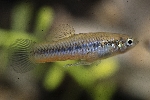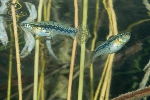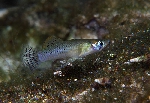Systematics and Biogeography of the Genus Gambusia (Cyprinodontiformes: Poecilidae)
American Museum Novitates, (295):74 10-ago.-1989
" The systematic and biogeographic relationships of the poeciliid genus Gambusia, a monophyletic group of 45 species, are examined in detail. As it focuses primarily on the interrelationships of subgenera and species groups, this work is not intended as a formal revision ofthe genus; however, areas where revisionary work are needed are pointed out. The genus has a sister-group relationship with the genus Belonesox, and these two in turn are related to the genus Brachyrhaphis. Gambusia vittata and the members of the rachowi species group, each previously assigned to monotypic genera, do possess the synapomorphies described for the genus Gambusia, and are thus included. Three subgenera within Gambusia are diagnosed: the subgenus Heterophallina, the subgenus Arthrophallus, and the subgenus Gambusia. The subgenera Arthrophallus and Gambusia are sister groups. Within the subgenus Heterophallina, the panuco and rachowi species groups are more closely related to each other than either is to G. vittata. In the subgenus Arthrophallus, the nobilis and senilis species groups are sister taxa, and in the subgenus Gambusia, the puncticulata and punctata species groups are sister taxa. Relationships within species groups also are described. This scheme of relationships, and the new classification derived from it, is a product of cladistic analysis of morphological characters. A complete descriptive osteology of Gambusia hispaniolae also is included, for comparison and reference.
Biogeographic analysis of the species groups of Gambusia concentrates on three areas. In southern Texas and northern Mexico, members of the affinis, nobilis, and senilis species groups overlap; their area cladograms are compared. The Rio Panuco basin of eastern Mexico is a meeting point for members of the subgenus Heterophallina, the senilis species group, and the affinis species group. A repeated pattern indicated a relationship between the Panuco basin and the Cuatro Cienegas basin of northern Mexico, with further ties to southern Mexico. Finally, links between Central America and the Greater Antilles are explored through the distribution patterns and area cladograms of the nicaraguensis, puncticulata, and punctata species groups. Repeated patterns include a relationship between Nuclear Central America (specifically Belize) and the Antilles, between Cuba and the Cayman Islands, and between eastern Cuba, Hispaniola, and the Bahamas. Whereas most of the Caribbean patterns do not strictly reiterate each other, the patterns are all consistent with each other. It is inferred that they represent different fragments of the complex history of Caribbean biogeography, and are compared with some published distributional information for other taxa "
Clasificación: Taxonomía y filogénia.
Idioma: English
Reference in bibliography for genera (3)
Referencia en bibliografía de especies (20)
Sustituciones de nombres
- Gambusia regani tratada como Gambusia regani, Gambusia panuco.
- Heterophallus echeagarayi tratada como Gambusia eheagayari [p. 3].
- Heterophallus rachovii tratada como Gambusia rachovii.
Rauchenberger, Mary. 1989. "Systematics and Biogeography of the Genus Gambusia (Cyprinodontiformes: Poecilidae)". American Museum Novitates. (295):74 (ffm00302) (resumen)













